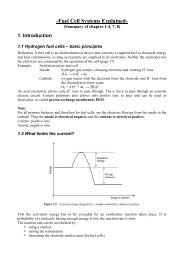Chapter 8. ORGANIC SOLAR CELLS - from and for SET students
Chapter 8. ORGANIC SOLAR CELLS - from and for SET students
Chapter 8. ORGANIC SOLAR CELLS - from and for SET students
You also want an ePaper? Increase the reach of your titles
YUMPU automatically turns print PDFs into web optimized ePapers that Google loves.
<strong>SOLAR</strong> <strong>CELLS</strong> <strong>Chapter</strong> <strong>8.</strong> Exciton solar cells<br />
the distance to the interface should be on the order of the exciton diffusion length. Despite<br />
their high absorption coefficients, exceeding 10 5 cm -1 , a 20 nm double layer of donor <strong>and</strong><br />
acceptor materials would not be optical dense, allowing most photons to pass freely. The<br />
solution to this dilemma is elegantly simple. By mixing the p <strong>and</strong> n-type materials, junctions<br />
throughout the bulk of the material are created that ensure each photogenerated exciton leads<br />
to charge transfer, irrespective of the thickness of the layer.<br />
Mixtures, or in other word blends, based on substituted fullerenes (with acronym<br />
PCBM) <strong>and</strong> DMOM-PPV (See Figure <strong>8.</strong>10) were among the first materials to utilize this<br />
bulk-heterojunction principle. Nevertheless, this attractive solution poses a new challenge.<br />
Photogenerated charges must be able to migrate to the collecting electrodes through this<br />
composite material. Because holes are transported by the p-type semiconductor <strong>and</strong> electrons<br />
by the n-type material, these materials should be preferably mixed into a bicontinuous,<br />
interpenetrating network. In Figure <strong>8.</strong>10 a bulk heterojunction solar cell is schematically<br />
depicted. The bulk heterojunction is presently the most widely used photoactive layer <strong>for</strong><br />
realisation of organic solar cells. The name bulk-heterojunction solar cell has been chosen,<br />
because the interface between two different components (heterojunction) is all over the bulk,<br />
in contrast to the classical (bi-layer) junction. Control of morphology is not only required <strong>for</strong><br />
a large charge-generating interface <strong>and</strong> suppression of exciton loss, but also to ensure<br />
percolation pathways <strong>for</strong> both electron <strong>and</strong> hole transport to the collecting electrodes.<br />
A<br />
B<br />
LUMO<br />
HOMO<br />
front<br />
HOMO<br />
electrode donor acceptor<br />
-<br />
glass<br />
transparent electrode<br />
-<br />
+<br />
LUMO<br />
back<br />
electrode<br />
100 nm<br />
metal electrode<br />
-<strong>8.</strong>14-<br />
O<br />
O S<br />
S<br />
S<br />
n<br />
MDMO-PPV<br />
n<br />
O<br />
OMe<br />
PCBM<br />
Figure <strong>8.</strong>10. (left) The bulk-heterojunction concept. After absorption of light by the polymer,<br />
fast charge transfer occurs due to the nanoscopic mixing of the donor <strong>and</strong> acceptor materials.<br />
Subsequently, the photogenerated charges are transported <strong>and</strong> collected at the electrodes.<br />
(right) Donor <strong>and</strong> acceptor materials used in polymer-fullerene bulk-heterojunction solar<br />
cells. Acceptors: PCBM: 3´-phenyl-3´H-cyclopropa[1,9][5,6]fullerene-C60-Ih-3´-butanoic acid<br />
methyl ester. Donors: MDMO-PPV = poly[2-methoxy-5-(3´,7´-dimethyloctyloxy)-pphenylene<br />
vinylene]; P3HT= poly(3-hexylthiophene);<br />
A breakthrough to truly appealing power conversion efficiencies exceeding 2.5%<br />
under simulated AM1.5 illumination was realized <strong>for</strong> bulk-heterojunction solar cells based on<br />
MDMO-PPV as a donor <strong>and</strong> PCBM as an acceptor. In PCBM, the fullerene cage carries a<br />
R<br />
R<br />
P3HT<br />
R






